August 2 - 8, 2015: Issue 225
Lisa Wilkes-Hunter
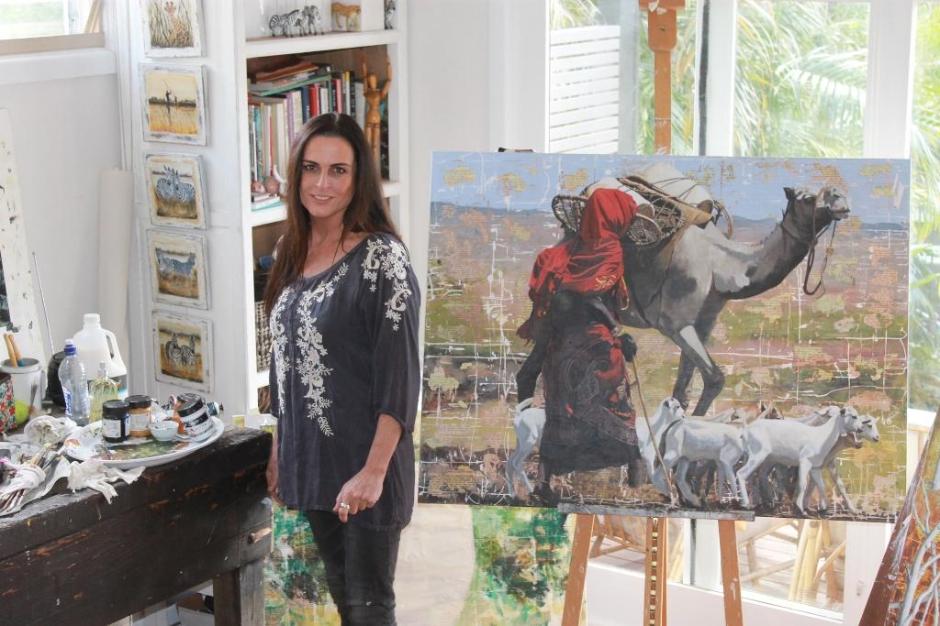
Lisa in her studio beside her 'Lady with a Camel'
Many know Lisa as the friendly face who oversees many of the weekend and evening game shows that occur in our loc
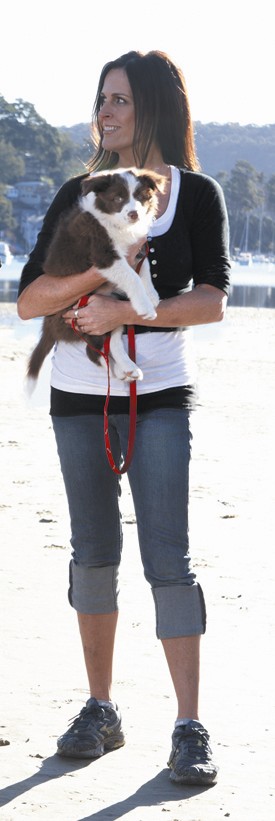
al clubs, a successful business she began several years ago. Lisa is also a wonderful mum of two though, and an artist who has been accepted into both the Mosman Art Prize and most recently accepted into the Warringah Art Prize 2015.
We are very privileged to share a small online exhibition of some of her works as our Artist of the Month for August 2015 and this week a small insight into what's inside that bubbly sparkling kindness:
When and where were you born?
In the 1960’s at Paddington Women’s Hospital. My parents were living in Narooma at the time and my dad Jim Moran was a Professional Golfer and was away on tour. My mum Fay Moran was staying with my grandparents at Whale Beach where we spent a lot of time. We moved to Avalon permanently when I was two years old.
What was it like growing up here?
It was wonderful. We were bush kids. Our parents rented a house in Tasman Road just a few doors down from Avalon Beach. They bought their first home in George Street and later bought a block of land in Joseph Street and built a lovely home.
We would walk to the beach through peoples’ backyards as there were no fences then. Our dog Lassie followed us everywhere. We were always in the bush and mangrove swamp as we lived right on it. We built tree houses, rode bikes and played with the neighbourhood kids until Mum called us home for dinner. We had a horse called ‘Tamba’ and we would ride to the pony club, where the tennis courts at Careel Bay are now. We would have gymkhanas there – it was fantastic.
What are the major changes you have noticed between then and now?
The population size - there are so many more people here now. There were many open plots of land. A lot of the bush is gone. When we were growing up there was a kindergarten behind our home in Joseph Street that was surrounded by bush and I remember a bushfire going through there and we all had to fight it with our garden hoses. The landscape was beautiful and lush and koalas and native wildlife roamed all over.
Where did you go to school?
I started at Avalon Primary School. My Father was the Pro at Cromer Golf Course for years and Tournament Director of the Australian PGA.
Due to my father’s profession we moved to Woodville Golf Course in the 70’s. My siblings and I were enrolled at Granville South High School. It was a good high school but a big change for us. I missed the beach every day. The area had many different cultures - Italians, Greeks, Vietnamese and Lebanese - and it was fantastic to be able to learn about other peoples’ cultures and eat their food. I think it made us more worldly and aware of other peoples’ viewpoints.
After we moved, my parents bought a block of land in Ruskin Rowe in Avalon. Every weekend we’d come back here, with plans to build their dream home, which they eventually did. In Guilford we lived on 8 acres at the back of the golf course.
It was a beautiful place. We played lots of golf, rode horses, mini bikes and drove golf cars and were always inviting friends home from school.
My sister and I were always bringing home stray animals and would spend our pocket money buying food for them. We loved animals and our house was a menagerie of sorts.
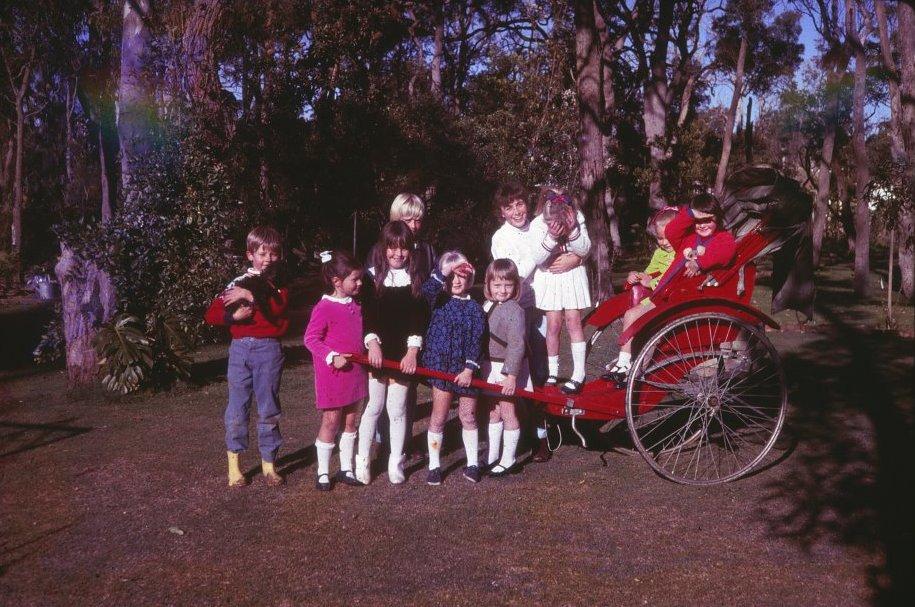
Melinda's party with rickshaw - back yard of 56 George St, 1960s
What did you do when you left school?
I started nursing at Auburn District Hospital. I did this for a couple of years and then decided nursing wasn’t for me. I loved being out on the wards with people but didn’t like the studying. I moved back to Avalon and it was then, at 21, when I met my husband, Greg. Sadly my wonderful father Jim Moran passed away suddenly from a massive heart attack before Greg and I were married. At this stage I was working three jobs: as a travel agent at Time Travel, a bartender at the Stoned Crow in the evening and at a photography shop early in the morning. I gave away the travel agency and worked for this wonderful guy, Warwick Short, who had a few different pubs around Sydney and in this way became part of the hospitality industry. After Hailey was born I had one year off, enjoyed being a mum then went to work at Avalon Beach RSL club. I was promoted there, became a Duty Manager eventually doing all their promotions.
Three jobs!: What were you saving for?
I had a really bad car accident when I was 18, a taxi driver went through a red light and squashed my Mini Minor, I sustained some nasty injuries. This was a real wake up call for me – I knew I wanted to have a family and buy a house one day. And I knew I wanted to be an artist.
This picture of a cat – you did this when 8 years old?
Yes, that was my first oil painting. Barry Chamberlain, a local Palm Beach artist and friend of my grandfather, author Richard Wilkes-Hunter, gave me painting lessons. Every winter my grandparents would go to Caloundra where Pop would write his novels. He entered ‘Siamese Cat’ into a competition in Brisbane and it won a prize. I had Liz Landers as my art teacher at school and was part of a composite class. My parents were great supporters of my creativity. My grandfather was probably the biggest supporter of my work.
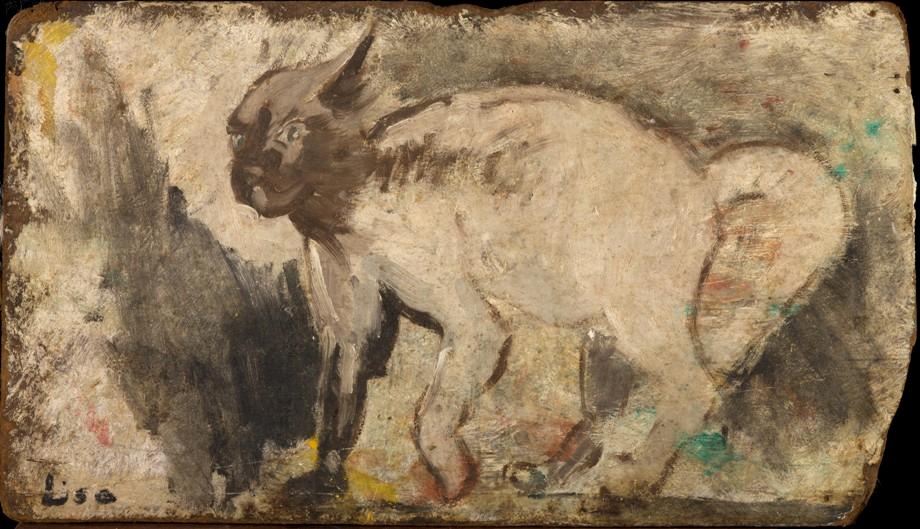
‘Siamese Cat’
What was the next painting you did?
I painted a picture of the Barossa Valley for my grandfather – he’d been there and asked me to do this. It was on cardboard and painted in acrylics. I remember being very excited when he hung it in his office.
What were your favourite subjects then?
Egypt! Anything Egyptian We had these little pet tortoises named Tutankhamen and Cleopatra with green and yellow shells. My ‘Tutankhamen’ painting was on a triangle shaped canvas, abstract, using the tortoise shell colours.
How did you return to being an Artist?
When Hailey and Tara were still quite young I decided to do more with my art, so I went and studied for five years at Seaforth TAFE to gain a Diploma of Fine Arts. I ended up majoring in Photography.
When I had finished this I thought ‘What do I do now?’ I looked at other art teachers and was daunted by how hard they worked – how did they get time to be artists?
I was already doing the promotions at the club and had an idea that I could design game shows that were fun to play in the clubs and, along with a friend, started a business based on this.
We ended up with game shows in pubs and clubs all over New South Wales and eventually hosted big promotions – giving away cars and boats and had people working for us as well. It became a really good business. My husband, Greg, was a clothing designer and manufacturer and he kept encouraging us and helped us along the way.
In 2002 we found out Greg had cancer. He was in Korea buying fabric and became sick. I went over to bring him home and we were there for almost a month. We had had a plan to renovate the house and had already done one section and had begun the next section. All through his illness Greg said ‘We’ve got to get the house finished’.
When he passed away the girls and I moved into my grandfather’s home in Whale Beach, which my mum still owned. I just loved it there. It was home to me. I was in Pop’s room and I could still imagine him sitting at his desk in front of his old upright typewriter, cigarette hanging on his bottom lip, typing away. He did give away the cigarettes and took up Wrigley’s PK chewing gum. I had a real spiritual connection to this home so it was good to be there after Greg died and while the renovations were being done.
When did you begin giving more time to your art – was it inspired by the trip to Africa?
Prior to my first trip to Africa in 2009, I started going to classes given by Nina Matthewson – a wonderful local artist and teacher. I attended her classes when I could and from learning a few new techniques managed to find my own style of work. Africa has definitely inspired me.
What are the Techniques you use?
What I do is use some of my own images, photographs, text from Pop’s books and incorporate these into my paintings. I do these in layers: an abstract background for the landscape and I will incorporate scratches into these and use wax and ink. I work on canvas and I like using board as well as I can scratch more lines and create different textures.
I like putting stuff into the work – so this one has sand in it. These are termed ‘mixed media’. I do installations, woodblocks and prints from these – this was a series called ‘Crazy Cat’.
All of this black here is where I’m drawing, and drawing really fast as I’m using hot melted wax on black paper.
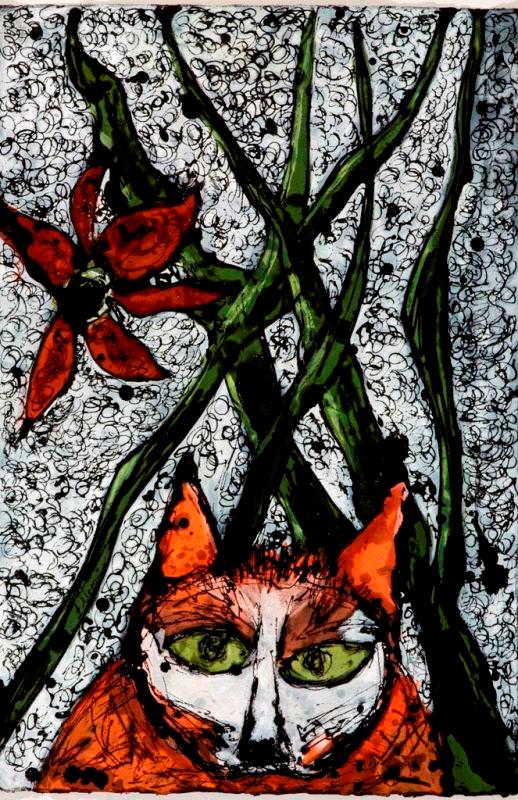
‘Crazy Cat’
One of my paintings is this Mandala – I use this as an inspiration for all my works still - this is my story. In here is me wanting to go to Africa, a lion (and I’m a Leo), these eggs are where I was developing the installations with an exhibition in mind. This is the sunshine, shining on us and this stems from ‘put your face always towards the sunshine and the shadows will all fall behind you’ – the butterflies are Hailey and Tara, my daughters and at the top is the Tree Of Life and that is for us, my daughters and myself, so we will be healthy and sheltered under the Tree of Life. These are the fires, the fires within you and the fires within your life and within each little interconnection is ‘GO’ which is for Greg Oates, my husband.
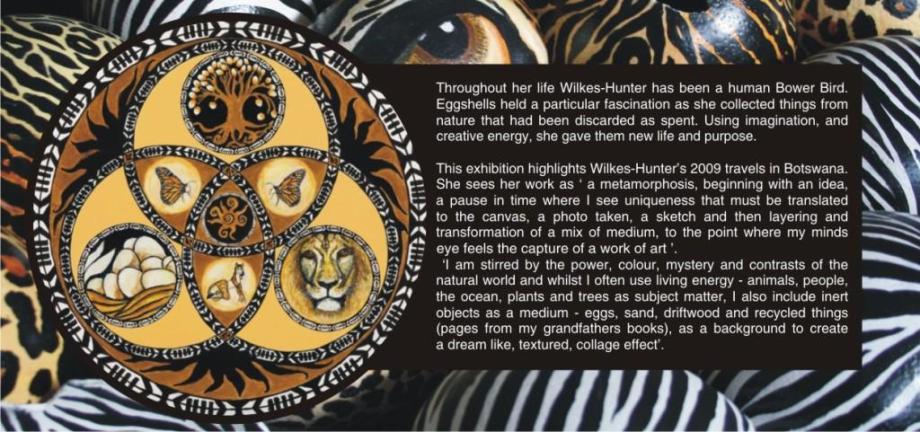
Wonderful – what’s on the Tree of Life – are they fruits or flowers?
They’re eggs and all three of us continuing to emerge from these in one way, as well as having come from them. I painted the ‘Mandala’ with the intention of going to Africa and then this actually manifested.
On my first trip to Africa we started off in Johannesburg South Africa and we travelled right through the middle of Botswana up into Zimbabwe. We visited the Okavango Delta which I would say had the biggest impact on me and inspired many of these works that led to the ‘Eyes on Okavango’ Exhibition.
Did you always want to go to Africa?
Yes, even as a kid I used to collect little lions and elephants. One of my favourite films is ‘Born Free’. Everyone is attracted to something and this is what I was attracted to.
A few years before travelling to Africa, I found out that my grandmother on my father’s side was born in South Africa during the Boer War and later, with her family, came to live in Australia. When I went to South Africa I did have a sense of a connection there and this may have contributed to that.
The ‘Eyes on Okavango’ series and Exhibition – how did that evolve?
I travelled to Botswana with a cousin and two friends and we visited Botswana then Zimbabwe and Victoria Falls. We visited an elephant sanctuary, which I loved of course. We then went back to South Africa and did what is called the ‘Garden Route’ which is a drive from Cape Town right along the base. From there we went up to Lesotho, a little land-locked country – and I’d like to do some paintings of Lesotho as well. I had done a few big landscapes already but mainly smaller paintings but after that trip I thought, ‘Hang on a moment, I can do big stuff’.
My grandfather had kept saying all the time “You’re good at this’ and he was an artist in his writing. Then I met artist Ted Blackall, one of Australia’s best and most prolific artists, and he told me I could do this. I consider him a friend and mentor. He’s very inspiring and positive and as he says ‘Anyone and everyone can paint’ and he says this so you know you can.
The ‘Eyes on Okavango’ exhibition was my first big solo exhibition at Freeman’s Reach in the Purple Noon Gallery. Ted was over here one day and I told him the exhibition was coming up. He said ‘If you’re going to have an Exhibition about Botswana you need someone from Botswana to open it’.
So I sent a letter to the Botswana Embassy asking if somebody would be interested in attending and opening the exhibition. The First Secretary to the High Commissioner of Botswana, Ms Wame Phetlhu attended and we had an instant rapport. She was very excited about the exhibition and a week later asked me if I could bring the exhibition down to Canberra to be part of ‘Windows to the World’ - a celebration of Canberra turning 100. My exhibition was in the Pula Hall of the Botswana Embassy.
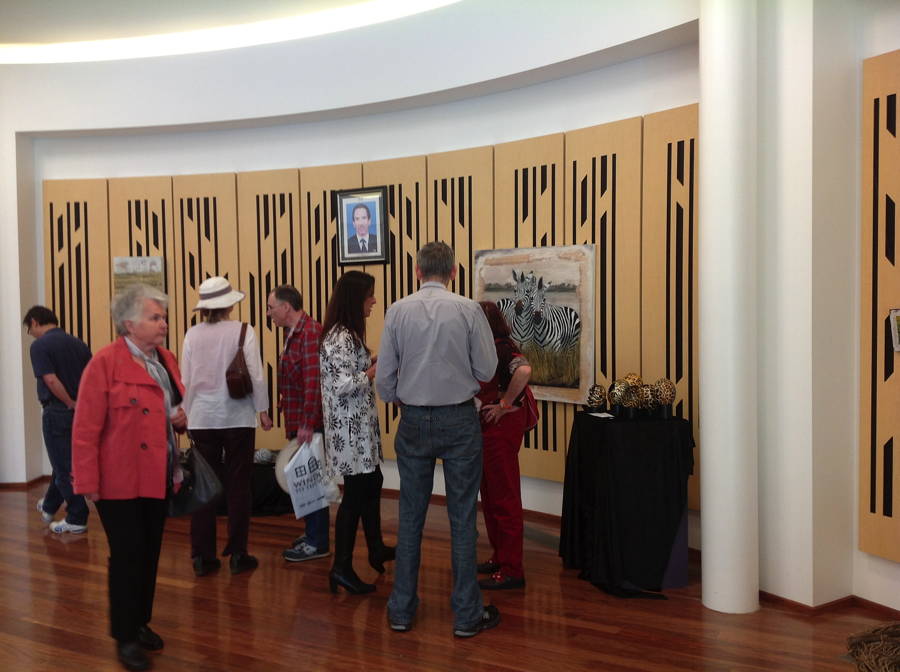
Lisa at ‘Eyes on Okavango’ Exhibition in the Pula Hall of the Botswana Embassy
How was it curating your own show?
My good friend, Justine Anderson and I hired a truck, loaded it with the art work and did a road trip down to Canberra.
Fortunately we were put in contact with an artist from Botswana who had held an exhibition at the Embassy previously and she explained that the walls there were big panels in the space and we’d have to bring everything we needed to hang the works properly. We arrived with fishing line and hooks, string, tape and everything else we could think of and hung it all ourselves.
It was a big event and was open to the public and hundreds of people attended. The Embassy asked me to leave it there for an extra week as they had other functions and events on during that period and were expecting visitors from other Embassies. I was fortunate to sell quite a few works there and people bought many of my installations.
Installations?
When I was studying I found myself drawn to eggs. I would go to the zoo and even there found myself drawn to eggs. Even as a child I collected eggs.
I have also begun collecting feathers – I never saw them before but after my sister died I saw them everywhere and began collecting them. I see them on my morning runs and everywhere else – and now I have boxes of them. As they say ‘when feathers appear, angels are near’. I am not sure what I am going to do with the feathers yet but for now I know there is a reason I am drawn to them.
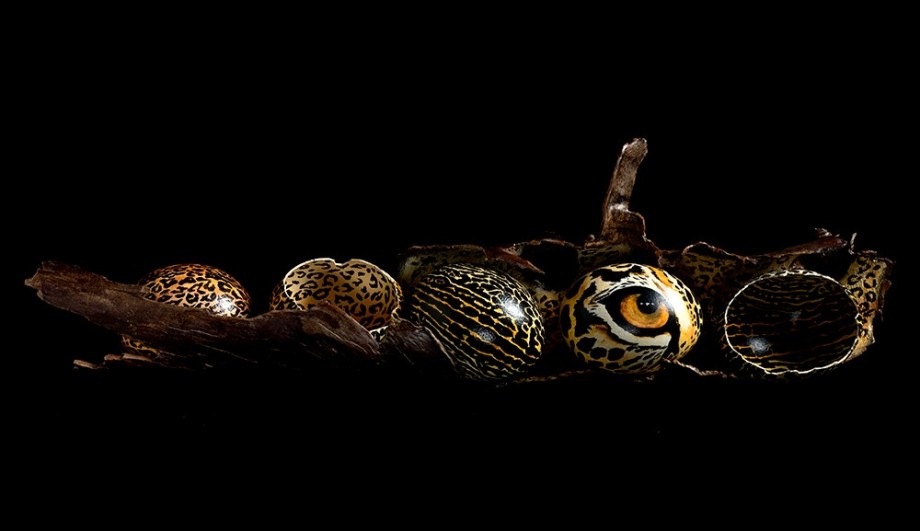
Leopard Eggs Installation
What did it feel like to sell these works?
It was a bit upsetting to be honest, like losing something precious. I thought, ‘Oh, I’m going to miss that’. They are like your babies in some ways, a part of you.
What have you been working on since ‘Eyes on Okavango’?
Last year was dedicated to looking after my sister Shelly who died from breast cancer in December. I did travel to Ethiopia and Kenya in January last year and some of these new works I’m beginning now stem from that trip.
What other Exhibitions have you been a part of?
I did put ‘The Giraffes’ in the Mosman Prize last year and it was chosen as a finalist. I was so thrilled to get into that exhibition. I have been in many group exhibitions over the years. I exhibited works when I was studying and also placed some in the Marine Art Show at the RMYC – I’ve put a few in there. And I have just been accepted for the Warringah Art Prize 2015
How would you describe the progression from doing these landscapes of our area to what you’re doing now?
I think the progressions occur because things happen in your life. Somebody close to you gets sick and you realise you have ‘here and now’ and that’s it. My approach is, as an artist, you have to explore it all – still lifes, landscapes, mixed media and then find what you love doing best, what brings out your own voice.
When I was studying I would take photographs and do paintings from these. I was trying out the different styles – still lifes, landscapes – all part of learning. When I look at the old works now it reminds me that I was always doing this. They reaffirm that I was getting on with it.
What I think has happened now and where I am at present, is that I’ve found something. I’ve found ‘it’ for me. This doesn’t mean I won’t progress further, simply that I’ve found my technique.
Before I could do this, I had do the other things – try out all these techniques and different media and then, in some ways, combine them all. Before doing my latest works I hadn’t even thought of creating works like these, or didn’t even think of doing this – so learning and gaining confidence, as well as remembering that I can do this, has led to these works.
I would also say it’s come from nature. When I get out in nature that’s when I start thinking, that’s where I think about a painting or a book I want to do. I usually go for a run each day and that is the time when I have that peace or space for this kind of thinking about what I will do when I get back into the studio and when I return I’m ready to work.
I’m still working on this painting of the lady with the camel. I’ve also started doing more of Pittwater – this one for example, of the magpies in the mangroves – that’s really me - and taking in the feathers and the birds, so I think after I do my next exhibition I’d like to get into doing more local stuff.
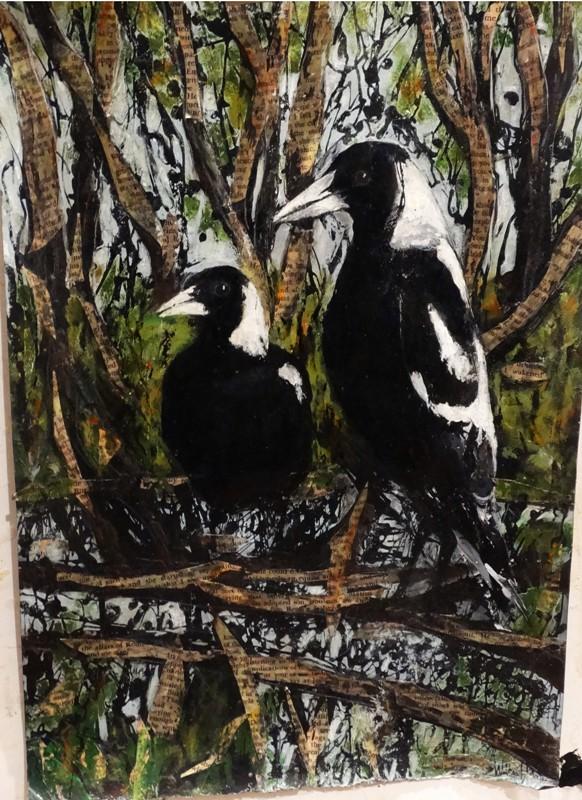
Magpies
I think I’m really lucky that my Grandad saw something when I was younger and encouraged it and then other people saw it and encouraged me too. I didn’t do it for a long time because I was being a teenager and then a mum and wife, but I knew that I had to do it, that I had to come back to doing it. I’m also lucky that I live here and have all this nature around me to inspire me as well as be a comfort, a place of respite on a daily basis.
I think that painting will be a big part of the rest of my life.
Is there any advice you’d give to anyone who is teetering on doing some form of creative work?
Just have a go – if you think you’ve got something - and everyone is different, no artist is ever going to be the same - you should pursue it and see what happens. Similarly I think if someone can see something in a very young person they should encourage them to pursue it, not drive them to, but encourage – perhaps give them some lessons or pointers and skills. I think it’s really important if people show some talent in some direction that they are encouraged and supported.
What is your next Exhibition?
The next is called ‘A Tale of Two Sisters’ and that will be on 17th of October this year. This will be with my sister Melinda Moran who is a wonderful artist photographer, it will be held in the old Wodonga railway station where there is now a restaurant and art space. This is part of a fundraiser called ‘Care Van’.
My cousin, John Brabant who is an orthodontist in Albury Wodonga, asked Melinda and I to do the exhibition last year. John started Care Van about eight years ago to help raise awareness of the plight of homeless people in Albury Wodonga, it is a growing program with many more Care Vans in NSW and Victoria. Each year Care Van has black tie dinner and our exhibition will be part of it. We’ve been down to check out the space. We were sitting out there having lunch on the old platform imagining what it must have been like 100 years ago with people coming and going, hats and old fashioned suitcases. It’s a fantastic space and has real atmosphere.
So the paintings you’re working on now, from the Ethiopia and Kenya trip will go into this Exhibition?
Yes. I took hundreds of photographs when I was over there and am working towards finishing these for October’s ‘A Tale of Two Sisters’.
Are you going back to Africa?
Yes, I plan to go to Tanzania. I’d love to meet Jane Goodall and hopefully do some volunteer work with animals – I’m not sure I’d get to meet her but obviously that would be a thrill. I’ve visited two elephant sanctuaries and want to do some volunteer work with animals in the future.
Who have your main influences on your art been?
My Grandad Richard Wilkes Hunter and my mum Fay Moran and dad Jim Moran formatively; they were always reading us books or giving us books to fire the imagination. They would always give me materials to use - paints and boards etc; and would enter my work into competitions.
My grandfather was great friends with William Dobell and had a limited edition book which Mr Dobell gave to him, where each page has an original print of the artworks – personally signed of course. I still have this book and love browsing through it.
And other painters whose works you love?
I loved Bridget Riley when I was growing up: all the movement in her works. I’m not sure whether that influenced the work I do of zebras, with their stripes and the tree branches around them, but I do try to capture movement and nature’s energy in my works. I remember going to one of her exhibitions and just staring at her paintings and thinking ‘whoa’ – it was a physical experience as well, so she was an influence while I was growing up.
Degas most certainly – my grandfather was mad on Degas and I still have one of the books that my grandfather had on him. My mum and I attended the Degas exhibition here a few years ago and I loved it.
Van Gogh and his Starry Night – when I look at that it reminds me of this experience with the lions in the waterhole.
We set off really early to go for a walk as soon as it was light in the Okavango Delta. There were five of us and our guide with just a stick!
I hope it was a long stick!
Well, it was quite long. I’m not sure what he was going to do with it. He did have an apprentice, a boy, who didn’t have a stick – he was training to be a guide, so I guess you have to graduate to having a stick.
We were being followed by this elephant bull and he said if it came at us to run as fast as we could and run in a zigzag because elephants have bad peripheral vision. We stopped at this waterhole to rest for a moment behind a log as it is very hot there. I was lying down and all of a sudden my friend Lynny said very quietly ‘Lion’.
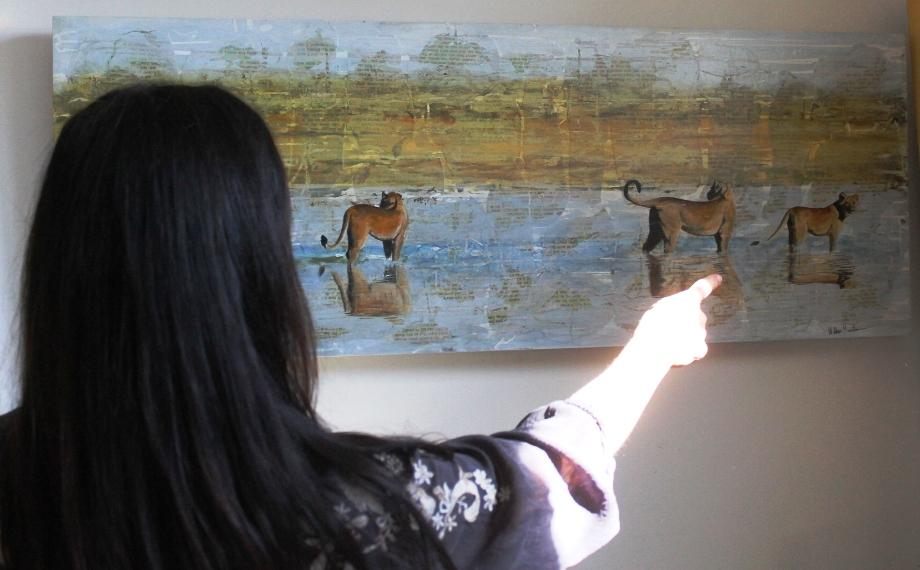
This one at the front here appeared first and these others began walking behind her. They were all watching the elephant too. There was a big ‘Crunch!’ as the elephant tore a branch off a tree and the little one took off into the bush – although this one at the front, the small young one, was watching us all the time. The other two then ran after the little one and this large one at the back then turned, stared us down, roared at us and she was the last to run off. All of this played out within a 60 metres of us, no fences, no cars, nothing to protect us, except the stick of course. It was a magical moment, we all just sat there for a moment in absolute silence and total awe. It’s moments like these you go back for. That is the feeling I got when I first saw that Van Gogh painting. That’s what I try and capture in my own works, the experience of it, so you can feel something, not just think.
My favourite contemporary artist is Joshua Yeldham. I love his affinity with nature.
This painting too is like that, this lady with the camel and the baby – we were in the Hurri Hills and came out of the desert and here she is walking along. I took the photo and am now working on finishing this painting.
I love the Old Masters’ works too– I liked going into the Cistine Chapel and the Louvre and looking at Michelangelo, Da Vinci and the old masters’ works there.
What are your favourite places in Pittwater and why?
Palm Beach – I love the big rock right at the end. In summer I walk up and down the beach every day. I feel there is something spiritual there and that when you get to the end there is an energy that I have felt in some other places. I can almost feel eyes on me, ancient eyes – perhaps the aboriginal people who were once there and that this is where we all come from really.
It is similar to what I felt last year when we went to Ethiopa - The Cradle of Mankind – that ancient spirit and spiritual connection we all have with nature and with each other.
What is your motto for life or a favourite phrase you try to live by?
“Who I am a creative passionate loving woman living each day to its fullest with integrity vitality and great courage.” That’s my mantra and that’s who I strive to be.
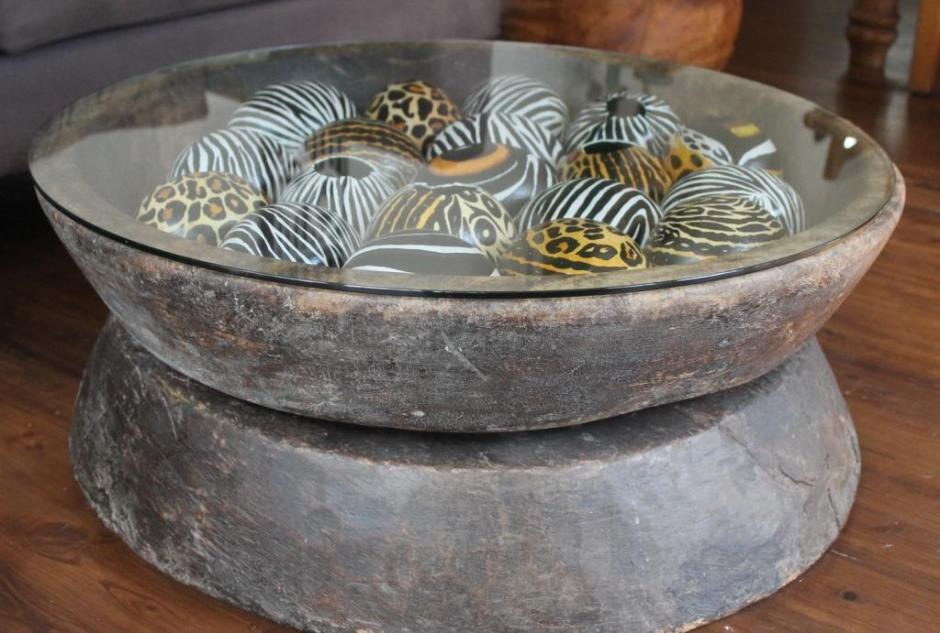
Lisa's Coffee Table - Installation Art!
Lisa in South Africa